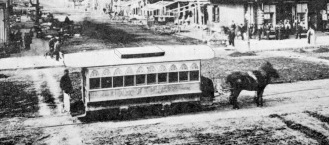
Settlers began coming to the Williamsport area in the mid-1700’s. They came either by flat boats poled upstream or by foot and pack horses over narrow Indian paths. Later, after 1772 when construction of several roads had begun, the settlers were able to use wagons.
Early Trolley Pulled by a Team of Horses
The first mode of public transportation in the area was the stagecoach. In 1809, when Williamsport had a population of just over 200 people, James Cummings, a local tavern owner, started stagecoach service between Northumberland and Williamsport. There was one scheduled trip per week and the 40-mile trip took 14 hours. By 1814 service had been extended to Jersey Shore.
However, in Williamsport in the 1800’s, as in most river communities of that time, transportation largely revolved around the river. The West Branch Division of the Susquehanna Canal, which was part of a statewide canal system, reached Williamsport in 1833 and Lock Haven in 1834. The canal was instrumental in the development of Williamsport as a lumbering center. As for passenger transport, this was provided by packet boats which were introduced sometime around 1838. These boats were towed by horses, relays of which were provided at certain points. In Williamsport the packet boats docked at the Exchange Hotel located on Market Street and their arrival always generated a great deal of excitement.
The Pennsylvania canal system was greatly damaged by the floods of 1889 and 1894. But its demise was near in any case as canals were already giving way to railroads as the principal means of intercity transportation.


